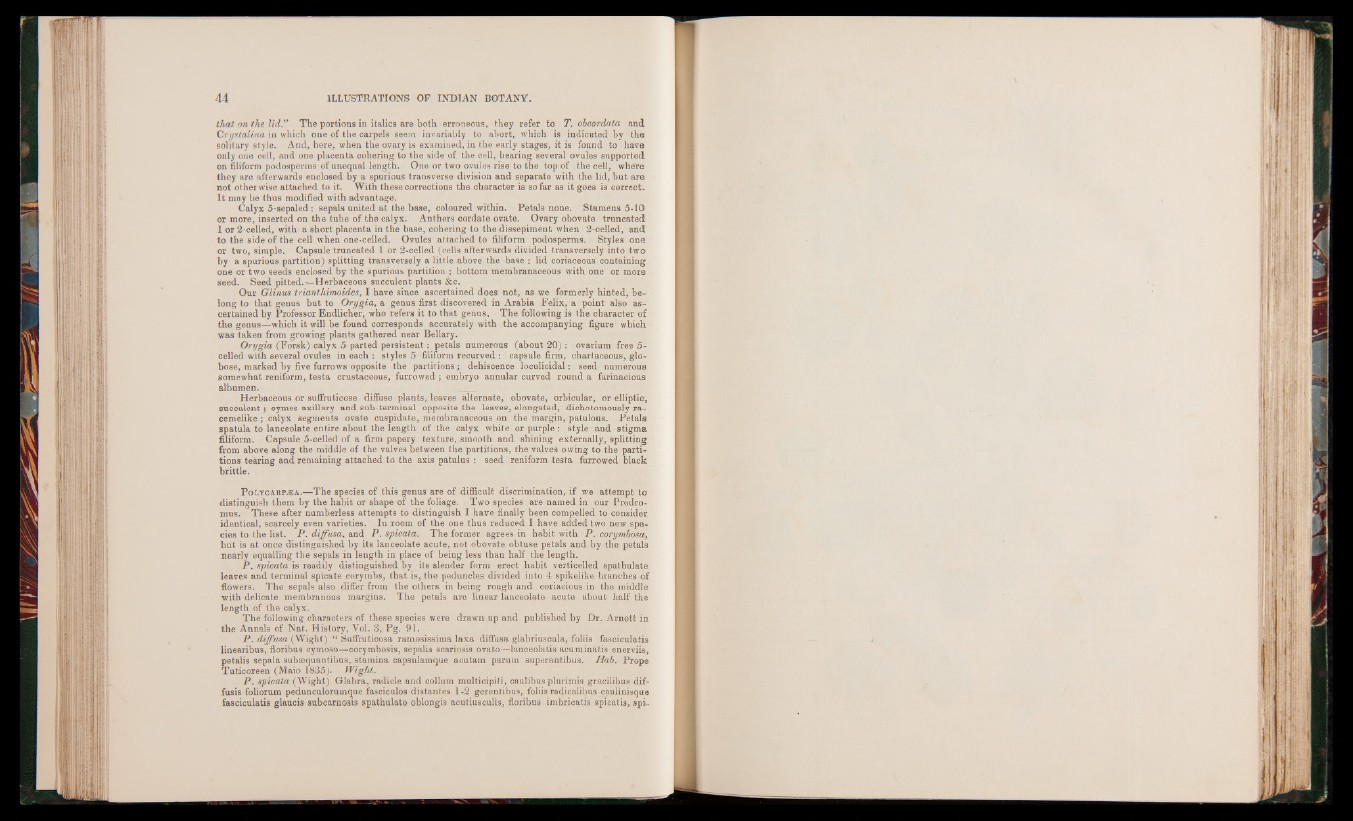
that on the lid,” The portions in italics are both erroneous, they refer to T. ohcordata and
OryStalina in which one of the carpels seem invariably to abort, which is indicated by the
solitary style. And, here, when the ovary is examined, in the early stages, it is found to have
only one cell, and one placenta cohering to the side of the cell, bearing several ovules supported
on filiform podosperms of unequal length. One or two ovules rise to the top of the cell, where
they arc afterwards enclosed by a spurious transverse division and separate with the lid, but are
not other wise attached to it. With these corrections the character is so far as it goes is correct.
I t may be thus modified with advantage.
Calyx 5-sepaled: sepals united at the base, coloured within. Petals none. Stamens 5-10
or more, inserted on the tube of the calyx. Anthers cordate ovate. Ovary obovate truncated
1 or 2-celled, with a short placenta in the base, cohering to the dissepiment when 2-celled, and
to the side of the cell when one-celled. Ovules attached to filiform podosperms. Styles one
or two, simple. Capsule truncated l or 2-celled (cells afterwards divided transversely into two
by a spurious partition) splitting transversely a little above the base : lid coriaceous containing
one or two seeds enclosed by the spurious partition ; bottom membranaceous with one or more
seed. Seed pitted.—Herbaceous succulent plants &c.
Our Glinus trianthimoides, I have since ascertained does not, as we formerly hinted, belong
to that genus but to Orygia, a genus first discovered in Arabia Felix, a point also ascertained
by Professor Endlicher, who refers it to that genus. The following is the character of
the genus—which it will be found corresponds accurately with the accompanying figure which
was taken from growing plants gathered near Bellary.
Orygia (Forsk) calyx 5 parted persistent: petals numerous (about 20) : ovarium free 5-
celled with several ovules in each : styles 5 filiform recurved : capsule firm, chartaceous, globose,
marked by five furrows opposite the partitions; dehiscence loculicidal: seed numerous
somewhat reniform, testa crustaceous, furrowed; embryo annular curved round a farinacious
albumen.
Herbaceous or suffruticose diffuse plants, leaves alternate, obovate, orbicular, or elliptic,
succulent; cymes axillary and sub-terminal opposite the leaves, elongated, dichotomously racemelike
; calyx segments ovate cuspidate, membranaceous on the margin, patulous. Petals
spatula to lanceolate entire about the length of the calyx white or purple: style and stigma
filiform. Capsule 5-celled of a firm papery texture, smooth and shining externally, splitting
from above along the middle of the valves between the partitions, the valves owing to the partitions
tearing and remaining attached to the axis patulus : seed reniform testa furrowed black
brittle.
PoLYCARFiEA.—The species of this genus are of difficult discrimination, if we attempt to
distinguish them by the habit or shape of the foliage. Two species are named in our Prodro-
mus. These after numberless attempts to distinguish I have finally been compelled to consider
identical, scarcely even varieties. In room of the one thus reduced I have added two new species
to the list. P. diffusa, and P. spicata. The former agrees in habit with P. corymbosa,
but is at once distinguished by its lanceolate acute, not obovate obtuse petals and by the petals
nearly equalling the sepals in length in place of being less than half the length.
P. spicata is readily distinguished by its slender form erect habit verticelled spathulate
leaves and terminal spicate corymbs, that is, the peduncles divided into 4 spikelike branches of
flowers. The sepals also differ from the others, in being rough and coriacious in the middle
with delicate membranous margins. The petals are linear lanceolate acute about half the
length of the calyx.
The following characters of these species were drawn up and published by Dr. Arnott in
the Annals of Nat. History, Vol. 3, Pg. 91.
P. diffusa (Wight) “ Suffruticosa ramosissima laxa diffusa glabriuscula, foliis fasciculatis
linearibus, floribus cymoso—corymbosis, sepalis scariosis ovato—lanceolatis acuminatis enerviis,
petalis sepala subeequantibus, stamina capsulamque acutam parum superantibus. Hab. Prope
Tuticoreen (Maio 1835> Wight.
P. spicata (Wight) Glabra, radicle and collum multicipifi, caulibus plurimis gracilibus dif-
fusis foliorum pedunculorumque fasciculos distantes 1-2 gerentibus, foliis radicalibus caulmisque
fasciculatis glaucis subcarnosis spathulato oblongis acutiusculis, floribus imbricatis spicatis, spi